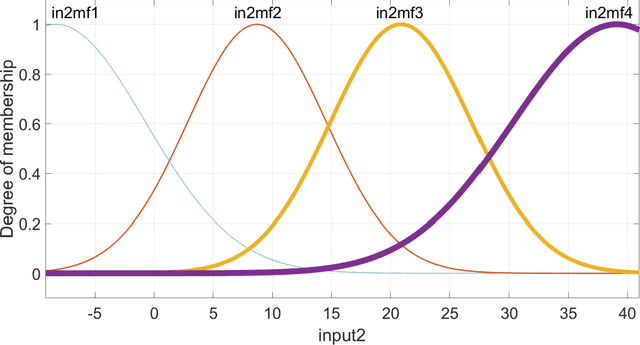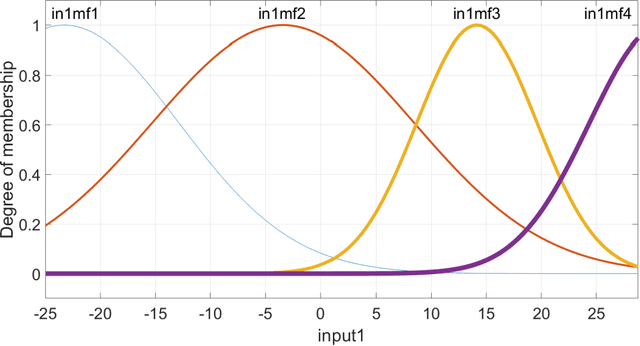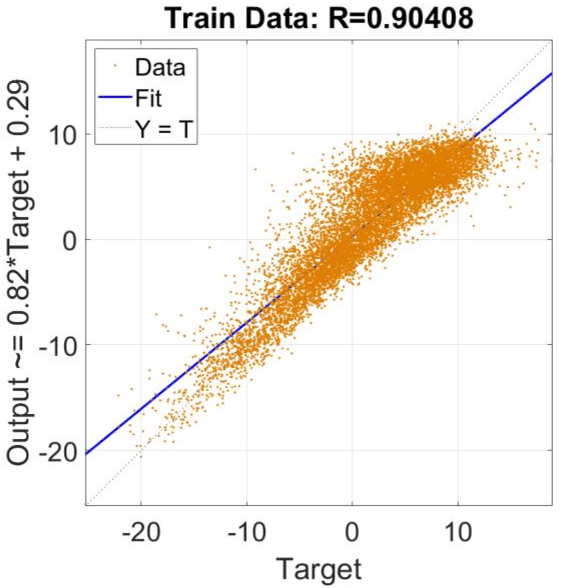Kwok-Wing Chau
Integration of neural network and fuzzy logic decision making compared with bilayered neural network in the simulation of daily dew point temperature
Feb 23, 2022



Abstract:In this research, dew point temperature (DPT) is simulated using the data-driven approach. Adaptive Neuro-Fuzzy Inference System (ANFIS) is utilized as a data-driven technique to forecast this parameter at Tabriz in East Azerbaijan. Various input patterns, namely T min, T max, and T mean, are utilized for training the architecture whilst DPT is the model's output. The findings indicate that, in general, ANFIS method is capable of identifying data patterns with a high degree of accuracy. However, the approach demonstrates that processing time and computer resources may substantially increase by adding additional functions. Based on the results, the number of iterations and computing resources might change dramatically if new functionalities are included. As a result, tuning parameters have to be optimized inside the method framework. The findings demonstrate a high agreement between results by the data-driven technique (machine learning method) and the observed data. Using this prediction toolkit, DPT can be adequately forecasted solely based on the temperature distribution of Tabriz. This kind of modeling is extremely promising for predicting DPT at various sites. Besides, this study thoroughly compares the Bilayered Neural Network (BNN) and ANFIS models on various scales. Whilst the ANFIS model is extremely stable for almost all numbers of membership functions, the BNN model is highly sensitive to this scale factor to predict DPT.
Prediction of flow characteristics in the bubble column reactor by the artificial pheromone-based communication of biological ants
Jan 09, 2020



Abstract:In order to perceive the behavior presented by the multiphase chemical reactors, the ant colony optimization algorithm was combined with computational fluid dynamics (CFD) data. This intelligent algorithm creates a probabilistic technique for computing flow and it can predict various levels of three-dimensional bubble column reactor (BCR). This artificial ant algorithm is mimicking real ant behavior. This method can anticipate the flow characteristics in the reactor using almost 30 % of the whole data in the domain. Following discovering the suitable parameters, the method is used for predicting the points not being simulated with CFD, which represent mesh refinement of Ant colony method. In addition, it is possible to anticipate the bubble-column reactors in the absence of numerical results or training of exact values of evaluated data. The major benefits include reduced computational costs and time savings. The results show a great agreement between ant colony prediction and CFD outputs in different sections of the BCR. The combination of ant colony system and neural network framework can provide the smart structure to estimate biological and nature physics base phenomena. The ant colony optimization algorithm (ACO) framework based on ant behavior can solve all local mathematical answers throughout 3D bubble column reactor. The integration of all local answers can provide the overall solution in the reactor for different characteristics. This new overview of modelling can illustrate new sight into biological behavior in nature.
Modeling Climate Change Impact on Wind Power Resources Using Adaptive Neuro-Fuzzy Inference System
Jan 09, 2020



Abstract:Climate change impacts and adaptations are the subjects to ongoing issues that attract the attention of many researchers. Insight into the wind power potential in an area and its probable variation due to climate change impacts can provide useful information for energy policymakers and strategists for sustainable development and management of the energy. In this study, spatial variation of wind power density at the turbine hub-height and its variability under future climatic scenarios are taken under consideration. An ANFIS based post-processing technique was employed to match the power outputs of the regional climate model with those obtained from the reference data. The near-surface wind data obtained from a regional climate model are employed to investigate climate change impacts on the wind power resources in the Caspian Sea. Subsequent to converting near-surface wind speed to turbine hub-height speed and computation of wind power density, the results have been investigated to reveal mean annual power, seasonal, and monthly variability for a 20-year period in the present (1981-2000) and in the future (2081-2100). The findings of this study indicated that the middle and northern parts of the Caspian Sea are placed with the highest values of wind power. However, the results of the post-processing technique using adaptive neuro-fuzzy inference system (ANFIS) model showed that the real potential of the wind power in the area is lower than those of projected from the regional climate model.
Simulation of Turbulent Flow around a Generic High-Speed Train using Hybrid Models of RANS Numerical Method with Machine Learning
Dec 25, 2019



Abstract:In the present paper, an aerodynamic investigation of a high-speed train is performed. In the first section of this article, a generic high-speed train against a turbulent flow is simulated, numerically. The Reynolds-Averaged Navier-Stokes (RANS) equations combined with the turbulence model are applied to solve incompressible turbulent flow around a high-speed train. Flow structure, velocity and pressure contours and streamlines at some typical wind directions are the most important results of this simulation. The maximum and minimum values are specified and discussed. Also, the pressure coefficient for some critical points on the train surface is evaluated. In the following, the wind direction influence the aerodynamic key parameters as drag, lift, and side forces at the mentioned wind directions are analyzed and compared. Moreover, the effects of velocity changes (50, 60, 70, 80 and 90 m/s) are estimated and compared on the above flow and aerodynamic parameters. In the second section of the paper, various data-driven methods including Gene Expression Programming (GEP), Gaussian Process Regression (GPR), and random forest (RF), are applied for predicting output parameters. So, drag, lift, and side forces and also minimum and a maximum of pressure coefficients for mentioned wind directions and velocity are predicted and compared using statistical parameters. Obtained results indicated that RF in all coefficients of wind direction and most coefficients of free stream velocity provided the most accurate predictions. As a conclusion, RF may be recommended for the prediction of aerodynamic coefficients.
 Add to Chrome
Add to Chrome Add to Firefox
Add to Firefox Add to Edge
Add to Edge